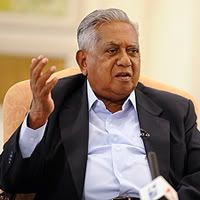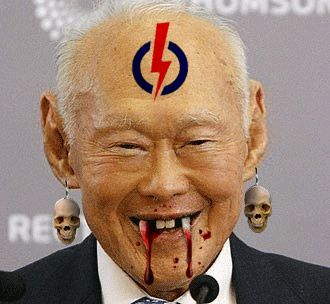- Joined
- Jul 24, 2008
- Messages
- 33,627
- Points
- 0
<TABLE border=0 cellSpacing=0 cellPadding=0 width="100%"><TBODY><TR>A war hero remembered
</TR><!-- headline one : end --><!-- Author --><TR><TD class="padlrt8 georgia11 darkgrey bold" colSpan=2>By K C Vijayan
</TD></TR><!-- show image if available --><TR vAlign=bottom><TD width=330>

</TD><TD width=10>
 </TD><TD vAlign=bottom>
</TD><TD vAlign=bottom>

-- Tomorrow marks the 65th anniversary of Lim Bo Seng's death.
</TD></TR></TBODY></TABLE>
<TABLE><TBODY><TR><TD>
 View more photos
View more photos
</TD></TR></TBODY></TABLE>
<!-- START OF : div id="storytext"--><!-- more than 4 paragraphs -->Stopping at Singapore war hero Lim Bo Seng's grave in MacRitchie Reservoir, one cannot help but notice from the inscription that this year is the centenary of his birth.
Lim was born on April 27, 1909. He was killed at the hands of the Japanese on June 29, 1944. Tomorrow marks the 65th anniversary of his death.
His grave, sited atop a hillock, is flanked by century-old trees and overlooks the placid waters of MacRitchie. It is possibly the largest grave site in honour of a single hero in Singapore.
As far as centenaries go, one could argue why Lim's deserves singular notice or why it has apparently gone unnoticed.
Major-General Lim was a contemporary of lawyer, politician and diplomat David Marshall. He was a year younger than Marshall and studied at the same Raffles Institution, then in Bras Basah Road.
But Marshall's legacy is well-documented, not just because of his achievements but also because of the collective memory contributed by those still living who remember him.
Hence a colossal biography by legal historian Kevin Tan, an extended exhibition by the National Library Board and a day-long seminar organised by the Institute of Southeast Asian Studies and four other bodies that marked Marshall's century-run last year.
Perhaps this brief of Lim's life would serve modestly to mark his centenary year.
Lim died at the young age of 35 in Japanese captivity at Batu Gajah prison in Malacca.
The 11th child of a Singapore businessman, Lim first studied in Xiamen, in China's Fujian province, and then continued his education at Raffles Institution when he was 16. Yusof Ishak, who was to become Singapore's first president later in life, was a classmate of his.
According to wartime comrade Lee Kim Chuan in the book, The Price Of Peace: Accounts Of The Japanese Occupation, a compilation of essays by survivors of the war, Lim went on to the University of Hong Kong but did not complete his studies as he had to return home to take care of the family business after his father died.
Among other things, the family owned land in Braddell Heights, ran a biscuit factory and a brickfield, and had interests in the construction industry.
'He did such an excellent job (running the family business) that his 18 brothers marvelled at his ability,' wrote Mr Lee.
Lim was an 'extremely talented and charismatic man', said Cambridge-educated Richard Broome, who was the deputy chief of Force 136 - a clandestine intelligence force set up by the British to work behind enemy lines. It comprised more than 100 men, mainly local Malayan Chinese.
Lim's name is inextricably linked to Force 136 as he had a hand in setting it up and bringing it to fruition, says the Ministry of Defence website in a section on his life.
Despite his privileged background and success as a businessman, Lim was staunchly anti-Japanese and a potential target for reprisal once they landed in Singapore.
In 1942, he left Singapore for Ceylon, now Sri Lanka, and then went on to India, where he was trained in intelligence by the British as part of Force 136.
He secretly returned to Malaya the following year and operated in the woods of Bukit Bidor, near Ipoh in Perak.
He later left his jungle hideout to infiltrate the towns in order to broaden the urban intelligence network and to seek funds from business contacts to support the cause.
But he was detained by the Japanese at an intersection in the outskirts of Gopeng, near Ipoh. It was the 13th day after he left Bukit Bidor, wrote colleague Tham Sien Yen in The Price Of Peace. Tham died in 2003.
Lim's steadfast refusal to talk to the Japanese and his ordeal in captivity - he was tortured - led to illness and death.
He kept his silence to the very end.
There are three aspects to his heroism.
First, the courageous decision to return to Malaya was his own as the British had considered it 'too dangerous' a mission for a man of his standing, said John Davis, the leader of the first batch of Force 136 agents who entered Malaya.
Second, his move to leave the hideout at Bukit Bidor to develop the network despite his comrades' warnings about the dangers of the mission.
And his final act of martyrdom, as noted in the Mindef website, lay in 'his steadfast refusal under pain and torture to reveal the information which would have endangered the lives of his comrades and the cause he was fighting for'.
He died two years and four months after he left his wife and seven children on Feb 11, 1942 to lead the underground resistance movement.
After the war, his remains were exhumed from the graveyard behind the prison by surviving Force 136 colleagues and taken to Singapore.
On Jan 13, 1946, an official funeral parade, replete with military honours, was carried out from City Hall to his final resting place at MacRitchie Reservoir. Five years later, a memorial was erected and dedicated at the site.
Much has been written to honour Lim. His wartime diary was donated to the National Museum by his family, and the Singapore Chinese Chamber of Commerce built a memorial in his memory at Queen Elizabeth Walk in 1959.
Every year on June 29, the dwindling numbers of those who survived him gather at this memorial in tribute to the man.
In this centenary year of his birth, one is reassured his graveyard will remain a permanent feature on the Singapore scene.
[email protected]
</TR><!-- headline one : end --><!-- Author --><TR><TD class="padlrt8 georgia11 darkgrey bold" colSpan=2>By K C Vijayan
</TD></TR><!-- show image if available --><TR vAlign=bottom><TD width=330>

</TD><TD width=10>


-- Tomorrow marks the 65th anniversary of Lim Bo Seng's death.
</TD></TR></TBODY></TABLE>
<TABLE><TBODY><TR><TD>

</TD></TR></TBODY></TABLE>
<!-- START OF : div id="storytext"--><!-- more than 4 paragraphs -->Stopping at Singapore war hero Lim Bo Seng's grave in MacRitchie Reservoir, one cannot help but notice from the inscription that this year is the centenary of his birth.
Lim was born on April 27, 1909. He was killed at the hands of the Japanese on June 29, 1944. Tomorrow marks the 65th anniversary of his death.
His grave, sited atop a hillock, is flanked by century-old trees and overlooks the placid waters of MacRitchie. It is possibly the largest grave site in honour of a single hero in Singapore.
As far as centenaries go, one could argue why Lim's deserves singular notice or why it has apparently gone unnoticed.
Major-General Lim was a contemporary of lawyer, politician and diplomat David Marshall. He was a year younger than Marshall and studied at the same Raffles Institution, then in Bras Basah Road.
But Marshall's legacy is well-documented, not just because of his achievements but also because of the collective memory contributed by those still living who remember him.
Hence a colossal biography by legal historian Kevin Tan, an extended exhibition by the National Library Board and a day-long seminar organised by the Institute of Southeast Asian Studies and four other bodies that marked Marshall's century-run last year.
Perhaps this brief of Lim's life would serve modestly to mark his centenary year.
Lim died at the young age of 35 in Japanese captivity at Batu Gajah prison in Malacca.
The 11th child of a Singapore businessman, Lim first studied in Xiamen, in China's Fujian province, and then continued his education at Raffles Institution when he was 16. Yusof Ishak, who was to become Singapore's first president later in life, was a classmate of his.
According to wartime comrade Lee Kim Chuan in the book, The Price Of Peace: Accounts Of The Japanese Occupation, a compilation of essays by survivors of the war, Lim went on to the University of Hong Kong but did not complete his studies as he had to return home to take care of the family business after his father died.
Among other things, the family owned land in Braddell Heights, ran a biscuit factory and a brickfield, and had interests in the construction industry.
'He did such an excellent job (running the family business) that his 18 brothers marvelled at his ability,' wrote Mr Lee.
Lim was an 'extremely talented and charismatic man', said Cambridge-educated Richard Broome, who was the deputy chief of Force 136 - a clandestine intelligence force set up by the British to work behind enemy lines. It comprised more than 100 men, mainly local Malayan Chinese.
Lim's name is inextricably linked to Force 136 as he had a hand in setting it up and bringing it to fruition, says the Ministry of Defence website in a section on his life.
Despite his privileged background and success as a businessman, Lim was staunchly anti-Japanese and a potential target for reprisal once they landed in Singapore.
In 1942, he left Singapore for Ceylon, now Sri Lanka, and then went on to India, where he was trained in intelligence by the British as part of Force 136.
He secretly returned to Malaya the following year and operated in the woods of Bukit Bidor, near Ipoh in Perak.
He later left his jungle hideout to infiltrate the towns in order to broaden the urban intelligence network and to seek funds from business contacts to support the cause.
But he was detained by the Japanese at an intersection in the outskirts of Gopeng, near Ipoh. It was the 13th day after he left Bukit Bidor, wrote colleague Tham Sien Yen in The Price Of Peace. Tham died in 2003.
Lim's steadfast refusal to talk to the Japanese and his ordeal in captivity - he was tortured - led to illness and death.
He kept his silence to the very end.
There are three aspects to his heroism.
First, the courageous decision to return to Malaya was his own as the British had considered it 'too dangerous' a mission for a man of his standing, said John Davis, the leader of the first batch of Force 136 agents who entered Malaya.
Second, his move to leave the hideout at Bukit Bidor to develop the network despite his comrades' warnings about the dangers of the mission.
And his final act of martyrdom, as noted in the Mindef website, lay in 'his steadfast refusal under pain and torture to reveal the information which would have endangered the lives of his comrades and the cause he was fighting for'.
He died two years and four months after he left his wife and seven children on Feb 11, 1942 to lead the underground resistance movement.
After the war, his remains were exhumed from the graveyard behind the prison by surviving Force 136 colleagues and taken to Singapore.
On Jan 13, 1946, an official funeral parade, replete with military honours, was carried out from City Hall to his final resting place at MacRitchie Reservoir. Five years later, a memorial was erected and dedicated at the site.
Much has been written to honour Lim. His wartime diary was donated to the National Museum by his family, and the Singapore Chinese Chamber of Commerce built a memorial in his memory at Queen Elizabeth Walk in 1959.
Every year on June 29, the dwindling numbers of those who survived him gather at this memorial in tribute to the man.
In this centenary year of his birth, one is reassured his graveyard will remain a permanent feature on the Singapore scene.
[email protected]



